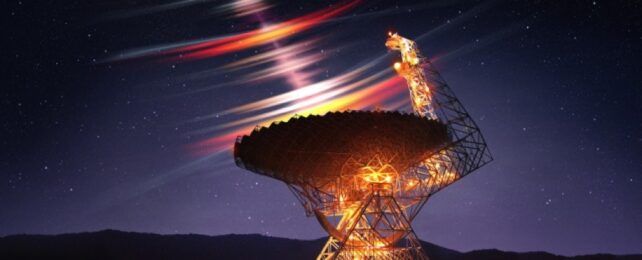A recent study published in Nature Astronomy examines the discovery of what astronomers are dubbing "ultra- fast radio bursts", a new type of fast radio bursts (FRBs) that the team determined lasts for a mind-boggling ten millionths of a second or less.
Traditionally, FRBs have been found to last only thousandths of a second, but this study builds on a 2021 study that hypothesized FRBs could possibly last for millionths of a second.
This also comes after astronomers recently announced the discovery of the oldest and farthest FRB ever observed, approximately 8 billion light-years from Earth.
"During our group meetings, we often talked about it," said Mark Snelders, who is a Ph.D. candidate at ASTRON and the University of Amsterdam (the Netherlands), along with being lead author of the most recent study and a co-author on the 2021 study.
"By coincidence, I found out that there was a public dataset that we could use for this."
For the study, the team was able to obtain five hours of data on a known FRB called FRB 20121102A, which was discovered in November 2012 and is located approximately three billion light-years from Earth, along with being considered the first known repeating FRB, according to a 2022 study.
The data was obtained from the Breakthrough Listen project, which is a worldwide scientific collaboration with the goal of finding evidence of extraterrestrial intelligence, with the data specifically coming from the Breakthrough Listen at Green Bank portion of the Open Data Archive.
Upon obtaining the data, the team took the first 30 minutes and split each second into 500,000 separate images, then incorporated machine learning and software filters to isolate outliers within the data to identify eight ultra-fast radio bursts lasting a mere ten millionths of a second or less. For context, 0.0000001 seconds is a tenth of a millionth of a second.
The researchers note, "In detecting and characterizing these microsecond-duration bursts, we show that there exists a population of ultra-fast radio bursts that current wide-field FRB searches are missing due to insufficient time resolution. These results indicate that FRBs occur more frequently and with greater diversity than initially thought. This could also influence our understanding of energy, wait time, and burst rate distributions."
While questions remain as to how these ultra-fast radio bursts are produced, the team does expect to identify more ultra-fast radio bursts in the future. However, the difficulty lies in finding data files capable of being split into 500,000 separate images per second, as some files lack the necessary specifications to make such splitting possible.
The long-term goal for the team is to use FRB data to map the space that exists between stars and galaxies, which they hope will help them gain better insights into the interactions between galaxies and the gas in the surrounding environment.
FRBs are some of the most mysterious celestial phenomena ever studied ever since they were first discovered in 2007, and astronomers have made incredible strides in both understanding their potential origins and the number of FRBs that exist in the universe. This includes discovering that most FRBs come from outside our Milky Way Galaxy.
However, in 2020, astronomers found one source of FRBs was from a magnetar within our own Milky Way Galaxy. Also, while FRB 20121102A is designated as the first known repeating FRB, a 2023 study identified 25 regularly repeating FRBs found using the Canadian Hydrogen Intensity Mapping Experiment (CHIME), which is located in British Colombia, Canada, and has found more than 1000 FRBs to date.
What new discoveries about FRBs ultra-fast radio bursts will astronomers make in the coming years and decades? Only time will tell, and this is why we science!
This article was originally published by Universe Today. Read the original article.
